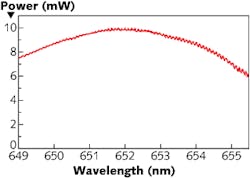Commercial tunable lasers typically use a scanning optical-grating technique that requires very high-accuracy maintenance of a rotational pivot point. However, a new tunable design from the Wireless Optoelectronic Research & Innovation Centre (WORIC) at the University of South Wales uses an etalon-based design that enables the tuning of etalon-transmission-peak wavelength and laser cavity length simultaneously without the need for complex scanned-grating designs that are subject to mode hopping and short lifetimes. Because the etalon transmission peak and the cavity length only depend on the orientation (angle) of the tuning unit, the selection and stability of the pivot point and any translational movements have no deleterious effect on mode-hop-free laser performance. This pivot-point-independent and translation-movement-insensitive design also reduces manufacturing costs and provides faster tuning speed and longer lifetime than grating-based tunable lasers.
Customizable to any specific wavelength spanning the ultraviolet to the mid-infrared range, the operating wavelength is only limited by the gain spectrum of the laser diode used in the system; WORIC tunable lasers centered at 650 nm and 1550 nm have a greater-than 7 nm and greater-than 40 nm tuning range, respectively. Compared to greater-than 30 GHz mode-hop-free tuning ranges for grating-based lasers, the etalon-based laser has greater-than 1000 GHz mode-hop-free tuning in an assembly measuring 80 × 80 × 100 mm3. The output power can also be optimized up to 10 mW in the UV to mid-visible range for telecommunications, optical coherence tomography, spectroscopy, and industrial-inspection applications. Contact Dennis Camilleri at[email protected].
